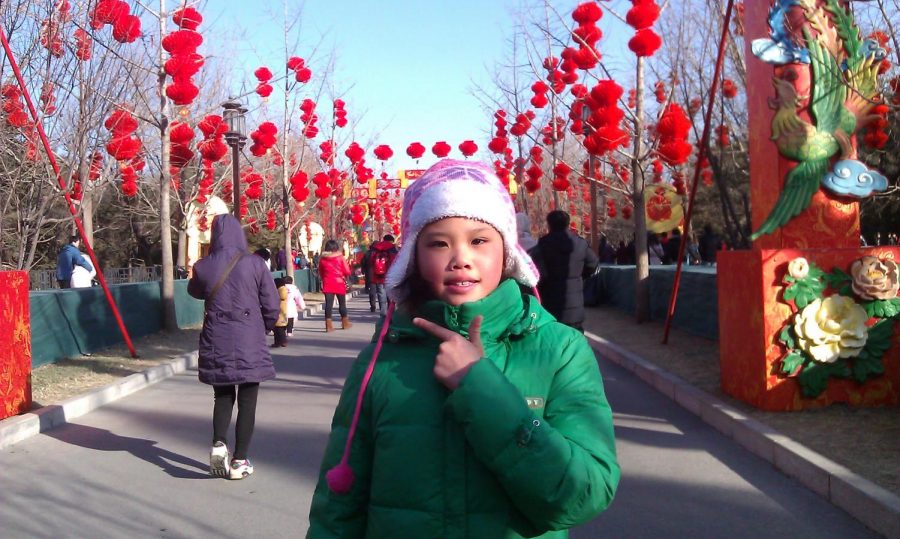Welcoming the spring with Chinese New Year
February 26, 2020
Using a wooden rolling pin, junior Chunlin An flattened a ball of dough on top of the black and white checkered tablecloth covering her dining room table. Littered across the table were all the dumpling-making necessities: shiny red and yellow trays, bowls filled with stuffing, a jar of flour, rolling pins and little balls of dough. An, her family and her friends were preparing dumplings for their Chinese New Year celebration.
“My family tradition is that we do everything by ourselves; we cook the stuffing and make the dumpling wrappers with flour and water,” An said. “When you do something with your family, it feels unique.”
In the midst of chatting and pinching, An’s mother slipped a sweet candy into one of the dumplings, ready to surprise its recipient with a rich, sweet new year.
For many students, Jan. 25 was an ordinary half-day. But for students celebrating the Year of the Rat, like An, it was a day of festivities and family gatherings. Chinese New Year, or Spring Festival, is a time to reconnect with family and welcome a fresh start. In China, winter break includes Spring Festival, and the entire nation observes the holiday.
For the second year in a row, juniors Lily Yin and Jiahe Jin went to the Chinese Embassy with their families to celebrate Chinese New Year. There, they ate dumplings and fish, watched traditional singing and dancing performances, and tuned in to the televised Spring Festival Gala — a popular show for New Years Eve featuring music, dance, martial arts, two-person comedy and more.
As part of a widespread Spring Festival tradition, Yin and Jin received red envelopes from family members filled with pocket money. Yin received electronic envelopes from her relatives in China, which included messages wishing her a happy new year.
During the weeks leading up to and following Chinese New Year, people decorate their homes with red lanterns, ornaments and banners.
“We usually hang up this one character representing good luck,” An said. “We write it on red paper and hang it on a wall.”
The custom of hanging red decorations, along with another tradition of lighting fireworks, comes from an old Chinese story about a dragon-like monster named Nian, An said. The monster would terrorize people every New Years Eve, stealing their children and ruining their harvest. According to the legend, a wise man encouraged everyone to decorate their homes in red and light fireworks to scare Nian away. Now, the color red symbolizes good luck in Chinese culture.
Yin and Jin’s families also both clean their houses before the New Year, a convention that symbolizes a fresh start.
“It’s a total clean up. We clean the floor; we do everything,” Jin said. “It took us almost a whole day.”
Junior Steven Wang’s whole family is in the U.S., so he said Chinese New Year doesn’t feel that different from celebrating in Beijing. However, he said he does miss the fireworks that people would light on the streets of the city.
“It’s really hard to get fireworks here,” Wang said. “I can’t just light fireworks at midnight in my neighborhood.”
Though Yin loves celebrating Chinese New Year with other families in the U.S., she says it isn’t the same as partaking in the festivities with her relatives in China. When she lived in Beijing, she would sometimes travel with her family to visit her grandmother in Yongxin County, Jiangxi Province. She misses the local traditions of the holiday, she said.
“In my hometown, we are not supposed to take out the trash on Chinese New Year,” Yin said. “It is said that if you take out trash, you take out good luck.”
MCPS excuses students from school for celebrating Chinese New Year, but many students chose to attend school rather than missing classes and assignments.
“Here in the U.S., we celebrate it, and we’re like, ‘Oh, it’s like a Chinese festival, whatever,’” An said. “But, back in Shanghai everyone else is celebrating it, and everyone else has that sense of ‘a new year is coming.’”
When An lived in China, she’d spend the break reconnecting with her extended family, who would travel to Shanghai for a massive New Years dinner. This year, because her relatives still live in China, An’s family decided to invite other Whitman families to celebrate the new year with them.
In Shanghai, An, at eight years old, lay in bed after New Years Eve. Outside her window, she could see the glow of fireworks and could hear their crackling explosions and the miscellaneous cheers from the streets below.
Even though she was alone in her bedroom, she felt “like the world was celebrating with [her].”








